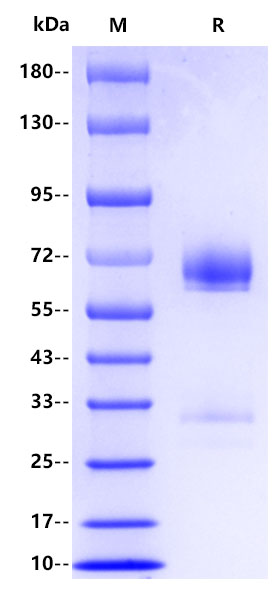Protein sequence(Q9Y5C1, Ser17-Glu460, with C-10*His) SRIDQDNSSFDSLSPEPKSRFAMLDDVKILANGLLQLGHGLKDFVHKTKGQINDIFQKLNIFDQSFYDLSLQTSEIKEEEKELRRTTYKLQVKNEEVKNMSLELNSKLESLLEEKILLQQKVKYLEEQLTNLIQNQPETPEHPEVTSLKTFVEKQDNSIKDLLQTVEDQYKQLNQQHSQIKEIENQLRRTSIQEPTEISLSSKPRAPRTTPFLQLNEIRNVKHDGIPAECTTIYNRGEHTSGMYAIRPSNSQVFHVYCDVISGSPWTLIQHRIDGSQNFNETWENYKYGFGRLDGEFWLGLEKIYSIVKQSNYVLRIELEDWKDNKHYIEYSFYLGNHETNYTLHLVAITGNVPNAIPENKDLVFSTWDHKAKGHFNCPEGYSGGWWWHDECGENNLNGKYNKPRAKSKPERRRGLSWKSQNGRLYSIKSTKMLIHPTDSESFEGGGGSHHHHHHHHHH
12 months from date of receipt, -20 to -70 °C as supplied. 6 months, -20 to -70 °C under sterile conditions after reconstitution. 1 week, 2 to 8 °C under sterile conditions after reconstitution. Please avoid repeated freeze-thaw cycles.
Angiopoietin-like 3, also known as ANGPTL3, is a member of the angiopoietin-like family of secreted factors. It is expressed predominantly in the liver, and has the characteristic structure of angiopoietins, consisting of a signal peptide, N-terminal coiled-coil domain, and the C-terminal fibrinogen (FBN)-like domain. The FBN-like domain in angiopoietin-like 3 protein was shown to bind alpha-5/beta-3 integrins, and this binding induced endothelial cell adhesion and migration. This protein may play a role in the regulation of angiogenesis. ANGPTL3 also acts as dual inhibitor of lipoprotein lipase (LPL) and endothelial lipase (EL),[7] thereby increasing plasma triglyceride, LDL cholesterol and HDL cholesterol in mice and humans.

Immobilized Human ANGPTL3, His tag at 4 μg/mL (50 μL/well) can bind ANGPTL3 Recombinant Rabbit mAb (SDT-425-59) (Cat. No. S0B3204) with EC50 of 1.370-1.651 ng/ml.

2μg (R: reducing conditions)